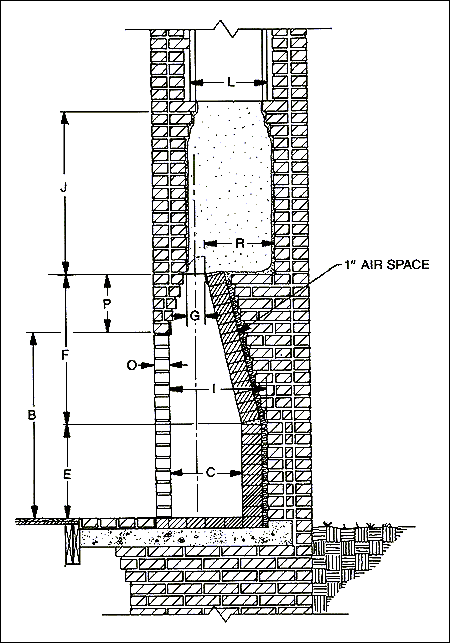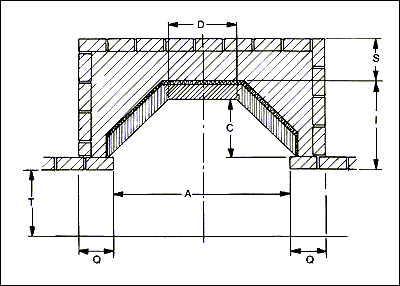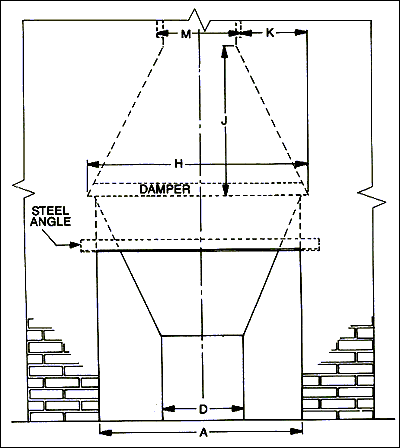Evaluation
by Jim Buckley, 6/2/99




COMMENT: Mostly accurate except what makes a Rumford is the shallow reflective firebox AND the rounded airfoil throat that works like a venturi or carburetor.Typical dimensions for Rumford fireplaces are provided in Fig. 4 and Table 1. However, these dimensions are not precise dimensions, but are dimensions based upon successful performance of constructed Rumford fireplaces. Rumford fireplaces have a reputation for allowing a small amount of smoke to enter the room while the fireplace is cold because of the narrow depth of the firebox. In addition to the concern of smoking, several of the fireplace dimensions in Fig. 4 may be in violation of local building codes, i.e., the narrow, 16 in. (400 mm) firebox hearth.
COMMENT: This paragraph needs total revision. Rumfords don't smoke if the throat is made correctly and all of the codes have been changed to permit the shallow Rumfords.

Rumford Fireplace with Clay Flue Liner

COMMENT: In throat flat dampers are now manufactured by Superior Clay, K&W Mfg and by Allied Mfg.The Rumford fireplace design is such that cold air flows down the chimney through the rear half of the flue. As this air flows downward, it is warmed and reverses its flow upward from the throat through the front half of the flue. If chimney top dampers are used, they must be properly selected so that they do not impair this air flow in the chimney, because it provides suction to increase the drafting of smoke and gases from the firebox. In addition to the flat plate and chimney top dampers, conventional dampers have been successfully used in Rumford fireplaces with only slight modifications in the design of the firebox and smoke chamber.
COMMENT: This is total BS as any engineer who thinks about it can plainly see. Air does not flow in two directions at once in the flue. The idea that cold air flows down the back of the flue while the warm air flows up the front of the flue is based on an old myth repeated by Vrest Orton and has no scientific basis.Another difference between a traditional Rumford fireplace and a conventional fireplace is the chimney. The original Rumford fireplaces had brick-lined chimneys. Thus, the dimensions for the Rumford fireplace provided in Table 1 have been slightly modified to accommodate modular clay flue liners. The result is a wider smoke shelf which may decrease the drafting capability of the assembly.
COMMENT: More hokus pokas.The effect of the performance of the Rumford fireplace by using dampers other than the flat plate damper, or using clay flue liners and a wider smoke shelf is not well documented. These modifications should be carefully considered and further modifications may be recommended by an experienced fireplace contractor.
COMMENT: Eliminate. Rumford thought you controlled the fireplace at the throat. That's not so hard to imagine. If you were going to tune a car engine would you hammer on the exhaust pipe or twist the little screws in the carburetor? Get the throat right and the flue doesn't matter much. In Rumford's day flues were large enough for sweeps to crawl up in.Rumford fireplaces greatly increase the amount of radiant heat obtained from the fireplace. The energy efficiency of the Rumford fireplace may be increased through the use of other energy-efficient features, such as supplying outside air and using glass screens which should be closed when the fireplace is not in operation.
COMMENT: Positive but unsupported mythology. Rumfords are efficient but "outside air and using glass screens" probably won't help.REFERENCES
1. "The Forgotten Art of Building A Good Fireplace", Vrest Orton, published by YANKEE magazine, Dublin, New Hampshire, 1974.
COMMENT: Vrest Orton was the founder of the Vermont County Store. He was an interesting and eccentric New England country store keeper (one of the only places you could buy red flannel underwear with a flap in the back) and, by his own admission, he was not an architect, engineer or any kind of fireplace expert. He wrote a little book to promote Rumford fireplaces based on his own 19th century "Rumford" which was undoubtedly a variation. His was not a scholarly work so where his "Rumford" differed from what Rumford actually promoted, he dithered and glossed over. Read and cite Rumford: Sanborn C. Brown, ed.; The Collected Works of Count Rumford; Harvard Univ. Press, 1969 (Five volumes - Vol II has Rumford's two essays on fireplaces)2. Book of Successful Fireplaces - How to Build, Decorate and Use Them, 20th Edition, R. J. and Marie-Jeanne Lytle, published by Structures Publishing Company, Farmington, Michigan, 1977.
COMMENT: This is just one of many secondary works on fireplaces published in the 1970's. It's not bad but it's no authority and Lytle is a carpenter.3. The Brick-O-Lator¨, Brick Association of North Carolina, Greensboro, North Carolina.
COMMENT: The Brick-O-Lator¨, Brick Association of North Carolina had nothing to say about Rumford fireplaces.4. Book of Successful Fireplaces - How to Build Them, 18th Edition, The Donley Brothers Company, Cleveland, Ohio, 1965.
COMMENT: The Donley Brothers Company was pivotal - basically responsible for re-inventing the masonry fireplace in the 1940's - but again had nothing to say about Rumfords.

Buckley Rumford Fireplaces
Copyright 1996 - 2001 Jim Buckley
All rights reserved.
webmaster